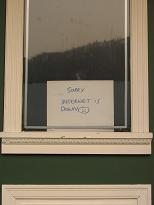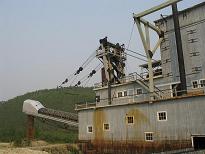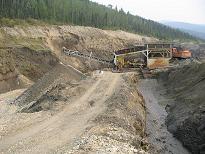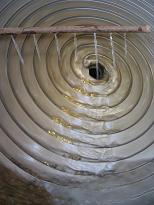Mawlers’ Big Adventure ’04:
Tourists in Dawson City
Monday, 9 August 2004
|
||||||||
|
On the way north, we enjoy Dawson City so much that we decide to stay an extra day on our way back. Besides, there is an internet cafe that lets us plug in the laptop. Priorities. There are a whole bunch of interesting things to do in Dawson City, so we actually buy tickets to some of them. We would like to see a Can-Can show in town and have a bunch of beer (not necessarily in that order), but that will need to wait until later tonight.
We start the day with a short walking tour of the Dawson City waterfront. The guides here are all dressed in a manner reminiscent of the 1880s/90s and this young lady is no differnt. They all look a tiny bit ridiculous, honestly. Regardless, the tour is informative on the Native Settlements. It might have been a touch rosy in its picture of relations between First Nations (natives) and Immigrants, though. The young lady claims that there are no Land Claims issues with First Nations in Yukon. I am not so sure that the First Nations councils would so readily agree, even with the most recent Land Claims Settlements, which are still being finalized. The general tour concludes with a specific look into the SS Keno. The Keno is a stern wheeler that is up on the dike right downtown in Dawson City. This is a very good reason for a tour, because there is no other way to see the boat and the internal workings are pretty interesting. We get a chance to look in the engine rooms, the boiler, etc. There are some great photos of various stern wheelers, including the Keno, which ceased operations in the 1950s and traveled to this spot under its own power in 1960.
The stern wheelers are essentially the same concept as the Mississippi River boats, but these are far more insane. The rivers up here are more shallow by far (the Keno has only a 24-inch draft fully loaded with 120 tonnes of payload!), have some very tricky rapids (the boats had to be pulled up river), and then there is the ice. There are loads of pictures of the boats stuck in the ice, waiting for the spring thaw. Needless to say, when the roads came, the boats went, but they lasted far longer than you would expect. After the downtown and Keno tour, we head out of town for tour number two. This one is of something called "Dredge No. 4". Sounds exciting, yes? Well, allow me to put on my lecture pose... The kind of gold they have in the Yukon is called "placer" gold (pronounced "plah-sir"). Placer gold is loose within the rock; all you need to do is separate it from the other rocks. Hence gold panning, where the heavy gold settles to the bottom of the pan and the lighter stuff all washes away.
Dredges are industrial strength gold panners. A toothless prospector can only churn through as much dirt as s/he can shovel into a pan and wash (or a sluice, but you get the point -- manual labor). So, someone invented a machine that can dig, sift, and wash in an automatetd fashion: a dredge. They come in all sizes, but Dredge No. 4 (a national historic site) is one of the biggest and this thing is frighteningly huge. The dredge has an arm in front with a series of huge iron buckets on an industrial conveyor belt. Each bucket on the dredge carries something like 7 cubic tonnes of dirt and the belt can move at an average 22 buckets per minute! They say that, while in operation, you could clearly hear the dredge 10 kilometers away in Dawson City. The dirt is passed through a huge rotating cylinder that lets small pieces through to the sluice-ways, which sift the gold out of the finer gravel. The larger gravel is spit out the back of the dredge, creating a tailing pile, which is just a pile of large stones with so little soil that nothing will grow in it.
Suddenly, it is clear what is going on around Dawson City. For kilometers along the road, all you see are huge piles of stones with small pools between them. In the mid-20th century, the entire valley was dredged by Dredge Nos 3 & 4. Kind of bleak, but definitely part of history. Another interesting point about dredges: they were actually boats. Because it washes the gravel, it just lives in its own pool, digging away the bank in front of it. When they run out of bank immediatly in front, they can pivot up to 180 degrees. After that is all gone, they move ahead a few feet and chew that up too. Most of the remaining dredges (this one included) were sunk in floods of some kind and just abandoned. This was definitely worth a look. Time to leave the dredge and the huge quantity of people on our tour. As big as the dredge is, it is crowded with about 40 people on a tour. Now we are dirving over to "Goldbottom" for a gold mine tour and gold panning. This is not far to go, but we have to negotiate the construction along the highway out of Dawson City. None of the locals understand the point of the construction and neither can we. The road is two lanes and the work they are doing looks like a four-lane road will result. A bit overkill, but it does provide a lesson in far north construction. If you get into construction, plan on spending some time. Turn off the engine, roll down the windows. You may wait up to 30 minutes for the ok to drive ahead. And when you do drive through, it is done with a "pilot car" (a guide) and the pace may be glacial at 20-30 km/hr (sometimes less).
Anyway, we make it to Goldbottom and sign up for our gold mine tour. We have little idea what this tour will be like, but are quite pleased to see that there are only two other people going. The woman nominally in charge begins the tour with some history of mining and some information about this particular claim. The most interesting fact about the Goldbottom claim is that it is a family mine. Having lived in rural Virginia for years, we are familiar with family farms, but this is a new one. We set off on the actual tour portion of the tour, driving up a rutted dirt road in an old Chevy Suburban with over 300,000 kilometers on the odometer and almost as many cracks in the windshield. (See, it is not just us.) On the way, she tells us that we will be going to see here older brother, who is mining up in the valley. Her brother took over from their father, who moved to Dawson City to work the telegraph and radio operations at a mine and got gold fever back in the 1950s. This mine has been in the family for a long time. They are basically doing the same thing that the old dredges did, with front-end loaders. They use bulldozers to break up the surface dirt, pushing it to one side. Then they use a hook on the back of the dozer to break up the permafrost, which they scrape away to the side, as well. When they get down to gravel and bedrock, they use a big tracked loader to dig it all up and pile it into a hopper, which feeds something very much like the old dredge.
They dam up the creek and pump the water through their gold sifting equipment. The spent water is collected in pools, allowing the silt to settle out of suspension before the water re-enters the creek. Once they are done with a section, new environmental laws require that they return the land to stability, by covering the gravel tailings with the finer dirt, shoring up the edges of the stream with some of the bigger rocks, and replantiing. This is where it gets interesting. This trip gives us a real educataion about mining. I had no idea how beneficial it is to the landscape, animal habitats, and stream health. I bet you did not know that either.
Our guide lets us in on this new perspective, beginning with a question from one of our tour mates. This older gent asks if there are fish in the Goldbottom Creek. Our tour guide informs us that there are none, but there will be when they get done. The streams are too narrow, shallow, cold, and subject to path changes. After the mining operations, the streams will be deeper and the edges more stable, so fish can move in. How hospitable. And we learn that mining releases all the nutrients in the land, which have been locked up in that "nasty old permafrost for centuries". Thank heavens. All of this can be summed up as "creating habitat for wildlife". No kidding. I could not make up these quotes. Returning to the main camp, we get to see how gold is separated from the sand using small machines, which are a huge improvement over panning.
Then the fun part; we go gold panning. Stepping into the water to pan, we are greeted by a 6-7 inch fish, swimming around our legs. I guess the habitat expansion program of mining is already working. Anyway, we manage to get several flakes of gold and, feeling quite satisfied, we decide to go back to Dawson City for dinner. I would recommend this tour, even for eco-nuts like me. It gives a differnt perspective. You might not agree with it, but hearing it is useful. And seeing the work being done is eye-opening. We conclude the day with a good dinner of beer and pizza at Mamacita's. The place is almost vacant and looks a bit chichi, but turns out to be a lot like Faccia Luna for those familiar with the DC area (or Penn State). |
||||||||
|
|
||||||||
|
The previous installment: |
The next installment: |
|||||||
Back to Great White North Trip main page
Back to Mawler Home
All materials © 2004 Lea Ann Mawler & Stuart Mawler




